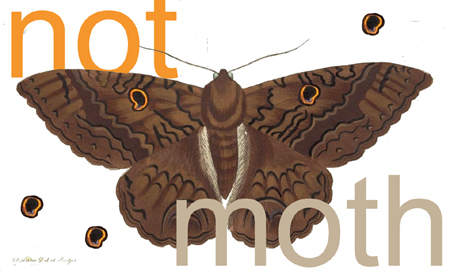Loss Pequeño Glazier About "Not-Moth" Given the many possibilities for this art form, a work of digital poetry might too often focus on its surface, like a shiny or curiously shaped digital goblet. Of course this is always the case when a new setting is placed at the table. To drink deeply, however, at some point one must address the liquid within the goblet. Not uncommon is an address to other works that somehow have resonance. "Not-Moth" takes its calling from Robin Blaser's "The Moth Poem", an early work that draws from the sounds that fill the house at night. Strange banging sounds within a piano -- the errant, distraction of being within strings, ghost-like -- more not music than music. Not music in any traditional sense, such sounds form the fount of the music of the poem. The sounds appear in a flurry of color, as the moth is a not-butterfly or the butterfly the true not-moth. Such an approach to poetry takes its calling from acts of listening, transcribing, allowing conscious intent to drift. Like the parts of poetry, like the mechanics of Lepidoptera, the poem works through functioning structure. It consists of varied patterns of stanzas; progressions of numbers lead to form. Yet, this also draws on deep structure. A stanza that displays four lines on the screen, for example, will consist of four lines each with four variants. Thus, a four line stanza is drawing from sixteen possible variants that each can appear as four different variants. For example, take the "music" array from "Not-Moth" 12. textAr[18] = "01 : the Muse, mystère, the other. The music's mesh-like draw. "textAr[19] = "02 : the Muse, musique, the other. The music's mesh-like draw. " textAr[20] = "03 : the Muse, mousikos, the other. The music's mesh-like draw. " textAr[21] = "04 : the Muse, mousikē, the other. The music's mesh-like draw. " In this simple example, where strings in an array vary in only one element, the changing form of "music" ("mystère, musique, mousikos, and mousikē") creates a music in an ambience of the mythic-mysterious drawn through a mist of linguistic, etymological, and moods of the word's underlying presence. Or in, the "syllable" array from "Not-Moth" 01. textAr[4] = "01 : stress of syllable's solo soul slur sound"textAr[5] = "02 : stress of syllable's solo slow sur-round" textAr[6] = "03 : stress of syllable's sad sol-o low sound" In these strings, the syllable's "solo sound" is dominated by slur. As variants are loaded, however, the sad, soulful sound becomes a "solo slur sound", a "solo sur-round", and even a "solo slur-round", as the similarity of words causes the reader to hear through mis-readings. In the granularity of such writing within coding, slight variations in the underlying parts determine displayed characteristics. Like base molecules in the DNA sequence, like the strings of the piano, each singe element of underlying strands combines to form the overall functioning work. Such structure follows works of the period, notably the "Structure of Rime", forms of Image-Nation, meticulous sequencing and structures of works of Duncan, Blaser, and Spicer's ghosts. Strings are components of arrays, JavaScript operates on arrays within the possibilities of programming. Language is content and code is language; digital language is both content and script-in-action. Thus "Not-Moth", partly paean to Blaser, partly celebration of the sort of "moth-ness" invoked by a night-small creature -- perhaps in fleeting contact with the back of your knee, perhaps within proximity of your hearing -- is likewise an investigation of the sounds of strings of another material, the literal strings of computer code. It is dedicated to the premise that lines expressed in multiples produce more than the sum of their parts; indeed, that a more ample sense of rhythms, senses, and by-ways of language, not even necessarily understood by the poet, can constitute the "sound" of the poem. The strings exist in clusters. They are "sounded" by the action of the code. The language that results is evoked, not enforced. It is in the side passages opening from the bursting word clusters that the resonance speaks. The moth sounds the strings inside the piano, the not-moth sounds the strings of code inside the poem's presence; in this way, the reader hears their own sounding of the not-moth's music, music within the strings, there for the waking. |
